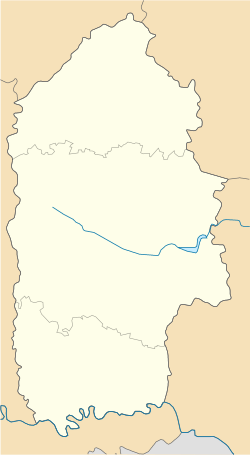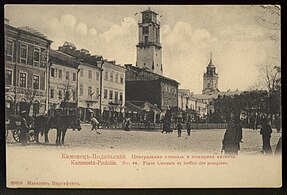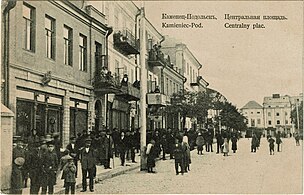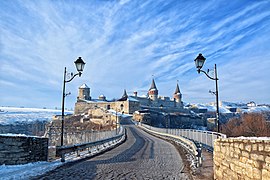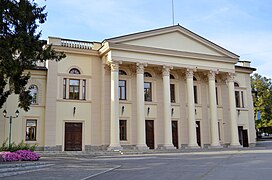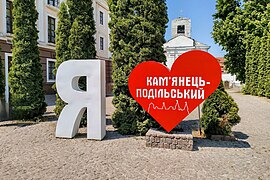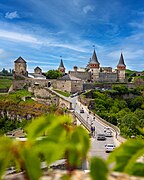Kamianets-Podilskyi
This article needs additional citations for verification. (July 2023) |
You can help expand this article with text translated from the corresponding article in Ukrainian. (July 2022) Click [show] for important translation instructions.
|
Kamianets-Podilskyi
Кам'янець-Подільський | |
|---|---|
| |
| Coordinates: 48°41′00″N 26°35′00″E / 48.68333°N 26.58333°E | |
| Country | |
| Oblast | Khmelnytskyi Oblast |
| Raion | Kamianets-Podilskyi Raion |
| Hromada | Kamianets-Podilskyi urban hromada |
| First mentioned | 1062 |
| City rights | 1432 |
| Government | |
| • Mayor | Mykhailo Positko |
| Area | |
• Total | 27,871 km2 (10,761 sq mi) |
| Population (2022)[1] | |
• Total | 96,896 |
| • Density | 3.5/km2 (9.0/sq mi) |
| Time zone | UTC+2 (EET) |
| • Summer (DST) | UTC+3 (EEST) |
| Postal code | 32300—32318 |
| Area code | +380-3849 |
 | |
Kamianets-Podilskyi[a] (Ukrainian: Кам'янець-Подільський, IPA: [kɐmjɐˈnɛtsʲ poˈdilʲsʲkɪj] ) is a city on the Smotrych River in western Ukraine, to the north-east of Chernivtsi. Formerly the administrative center of Khmelnytskyi Oblast, the city is now the administrative center of Kamianets-Podilskyi Raion within the oblast. It hosts the administration of Kamianets-Podilskyi urban hromada.[2] Population: 96,896 (2022 estimate).[1]
Kamianets-Podilskyi is a historical center of Podolia region, serving as a capital of the Duchy of Podolia, Podolian Voivodeship, Podolia Eyalet, Podolia Governorate, and Podolian District. During the Ukrainian–Soviet War, the city officially served as the temporary capital of the Ukrainian People's Republic from 1919 to 1920.[3]
Name
[edit]Originally known as Kamianec, its name was changed to the current following the partitions of Poland and occupation by the Russian Empire in 1795.
The first part of the city's dual name originates from kamin' (Ukrainian: камiнь) or kamen, meaning 'stone' in Old Slavic. The second part of its name relates to the historic region of Podilia (Ukrainian: Подíлля), of which Kamianets-Podilskyi is considered to be the historic capital. Therefore, the town name literally means 'The Stones of Podilia'.
Equivalents of the name in other languages are: Polish: Kamieniec Podolski; Romanian: Camenița Podoliei; Latin: Camenecium; Ottoman Turkish: كامانىچه, romanized: Kamaniçe; Hungarian: Kamenyeck-Podolszk; Yiddish: קאָמענעץ ,קאמיניץ, romanized: Komenets, Komenits;[4] Russian: Каменец-Подольский, romanized: Kamenets-Podolskiy; English: Kamenets-Podolsk.[5]
Geography
[edit]Kamianets-Podilskyi is located in the southern portion of the Khmelnytskyi Oblast, located in the western Ukrainian region of Podillia. The area where the city is located is part of the Podolian Upland which is notable for its elevated places known as Tovtry (see Podilski Tovtry National Nature Park) and creating a canyon-like relief feature.
The Smotrych River, a tributary of the Dniester, flows through the city. The total area of the city comprises 27.84 square kilometers (10.7 sq mi).[6] Among other notable neighboring cities, Kamianets-Podilskyi is located about 101 kilometres (62.8 mi) from the oblast's administrative center, Khmelnytskyi[6] and across Dniester in southwestern direction 88 kilometres (54.7 mi) from Chernivtsi, an administrative center of the neighboring Chernivtsi Oblast.
History
[edit]Classical antiquity
[edit]Several historians consider that a city on this spot was founded by the ancient Dacians, who lived in what is now modern Romania, Moldova, and portions of Ukraine.[7] Historians write that the founders named the settlement Petridava or Klepidava, which originate from the Greek word petra or Latin lapis 'stone' and Dacian dava 'city'.[7][8]
Kyivan Rus and the Tatars (11th c.–1241)
[edit]
Modern Kamianets-Podilskyi was first mentioned in 1062, when it belonged to smaller principality of Terebovlia, then Halych principality[9] and Kingdom of Galicia–Volhynia, as a town of the Kyivan Rus'[10] state. In 1241, it was destroyed by the Mongolian invaders.[11]
Polish rule (1352–1672)
[edit]
In 1352, it was inherited by the Polish King Casimir III. In 1374 the city was granted Magdeburg Law. In 1370, the Dominican monastic order began to function in Kamianets, a monastery was founded, and soon the Franciscans founded their own monastery in the city. Later, monks of other orders moved: Jesuits (1608), Discalced Carmelites (1623), Trinitarians (1699).[12] In 1378 it became seat of a Roman Catholic Diocese. In 1432 King Sigismund I the Old granted Kamieniec Podolski city rights. It was an important royal city of Poland. In 1434 it became the capital of the Podolian Voivodship and the seat of local civil and military administration.[11] The ancient castle was reconstructed and substantially expanded by the Polish kings to defend Poland from the southwest against Ottoman and Tatar invasions, thus it was called the gateway to Poland. In 1510, a peace treaty was signed in the city between Poland and the Principality of Moldavia.
During the free election period in Poland, Kamianets-Podilskyi, as one of the most influential cities of the state, enjoyed voting rights (alongside Warsaw, Kraków, Poznań, Gdańsk, Lwów, Wilno, Lublin, Toruń and Elbląg).
Ottoman rule (1672–1699)
[edit]
After the Treaty of Buchach of 1672, Kamianets-Podilskyi was briefly part of the Ottoman Empire and capital of Podolya eyalet. It was also sanjak of pasha (central sanjak) of this eyalet with nahiyas of Kropotova, Satanova, İskala, Kitayhorad, Kırıvçe, Zhvan (It was known as Ijvan during Ottoman rule) and Mıhaylov.[13] To counter the Turkish threat to the Polish–Lithuanian Commonwealth, King Jan III Sobieski built a fortress nearby, Okopy Świętej Trójcy (now Okopy, Ternopil Oblast; meaning "the Entrenchments of the Holy Trinity"). In 1674, local Armenians, who made up one of the main Armenian communes in Poland up to that point, were expelled by the Ottomans.[14] Most, after about three years of exile in the Balkans, moved to the territories remaining within Poland, chiefly Lwów and Stanisławów.[15]
In 1687, Poland attempted to regain control over Kamianets-Podilskyi and Podolia, when the fortress was unsuccessfully besieged by the Poles led by Prince James Louis Sobieski.
Polish–Lithuanian Commonwealth (1699–1793)
[edit]In 1699, the city was given back to Poland under King Augustus II the Strong according to the Treaty of Karlowitz. The fortress was continually enlarged and was regarded as the strongest in the Polish–Lithuanian Commonwealth. The preserved ruins of the fortress still contain the iron cannonballs stuck in them from various sieges.

During this period, Bishop Dembowski, at the instigation of the Frankists, convened a public disputation at Kamieniec Podolski, in November 1757, and ordered all copies of the Talmud found in his bishopric to be confiscated and burned.[16] Accounts of the Talmud burning differ—contemporary sources say that up to a thousand copies of the Talmud were destroyed, though other reports say only one copy was burned. Dembowski himself died days after the events.[additional citation(s) needed] A plague broke out and the local priests exhumed his body and cut the head off to prevent any further disaster.[17]
Russian rule (1793–1915)
[edit]After the Second Partition of Poland in 1793, the city belonged to the Russian Empire, where it was the capital of the Podolia Governorate. The Russian Tsar Peter the Great, who visited the fortress twice, was impressed by its fortifications. One of the towers was used as a prison cell for Ustym Karmeliuk, a prominent peasant rebel leader of the early 19th century, who managed to escape from it three times. In 1798, Polish nobleman Antoni Żmijewski founded a Polish theater in the city. It was one of the oldest Polish theaters. In 1867 the Roman Catholic Diocese of Kamianets-Podilskyi was abolished by the Russians authorities. It was re-established in 1918 by Pope Benedict XV.
According to the Russian census of 1897, Kamianets-Podilskyi remained the largest city of Podolia with a population of 35,934.
In 1906, the local society "Prosvita" was established in the city, thanks to its activities, the study of the Ukrainian language was introduced in primary and parish schools.[18] On 1 July 1910, more than 48 percent of the city's residents were Jews. The city was located in the settlement zone that the Russian Empire had set aside for Jews. In 1914, a direct railway line linked the city to Proskurov.
-
Lithograph of Napoleon Horda between 1862 and 1876
-
Kamianets-Podilskyi fortress 1865
-
Kamenets from a height, the beginning of the 20th century
-
Church of St. Nicholas, 1902
-
Polish market, centralny plac, 1906
-
Centralny plac, 1906-1910
-
Postova Street, to the right of the Jewish shops, Old Town, 1910
-
Kamianets-Podilskyi aerial survey, 1914
-
Austro-Hungarian troops enter the Kamianets-Podilskyi, 1918
-
Kamianets-Podilsky bridge, 1918
World War I and Ukrainian People's Republic
[edit]
During World War I, the city was occupied by Austria-Hungary in 1915.
After the collapse of the Russian Empire in 1917, the city was briefly controlled by the Ukrainian People's Republic and the Hetmanate[19] before ending up as part of the Ukrainian SSR when Ukraine fell under Bolshevik power. During the Directorate period, the city was chosen as de facto capital of Ukraine after the Russian communist forces occupied Kyiv.[20][19]
During the Polish-Soviet War, the city was captured by the Polish Army on the night of 16–17 November 1919[20] and was under Polish administration from 16 November 1919, to 12 July 1920 as capital of the Podolian District.
In July 1920 battles between units of the Army of the Ukrainian People's Republic (UPR) and the Red Army took place in the village Veliki Zozulintsi and surrounding villages nearby Kamianets-Podilskyi.[21] On 7 July 1920 soldiers of the 6th Reserve Rifle Brigade of the UPR Army were taken prisoner by the Bolsheviks.[21] After refusing to join the Red Army, captured UPR soldiers were executed.[21] In Veliki Zozulintsi a mass grave of 26 UPR soldiers is located.[21]
After the defeat of the Ukrainian People's Republic in the Ukrainian-Soviet war, the city was occupied by the Red Army. The area including Kamianets-Podilskyi was ceded to Soviet Ukraine in the 1921 Treaty of Riga, which determined its future for the next seven decades as part of the Ukrainian SSR.
Poles and Ukrainians have always dominated the city's population. However, as a commercial center, Kamianets-Podilskyi has been a multiethnic and multi-religious city with substantial Jewish and Armenian minorities. Under Soviet rule it became subject to severe persecutions, and many Poles were forcibly deported to Central Asia. Massacres such as the Vinnytsia massacre have taken place throughout Podillya, the last resort of independent Ukraine. Early on, Kamianets-Podilskyi was the administrative center of the Ukrainian SSR's Kamianets-Podilskyi Oblast, but the administrative center was later moved to Proskuriv (now Khmelnytskyi).
In December 1927, TIME Magazine reported that there were massive uprisings of peasants and factory workers in southern Ukraine, around the cities of Mohyliv-Podilskyi, Kamianets-Podilskyi, Tiraspol and others, against Soviet authorities. The magazine was intrigued when it found numerous reports from the neighboring Romania that troops from Moscow were sent to the region and suppressed the unrest, causing no less than 4,000 deaths. The magazine sent several of its reporters to confirm those occurrences which were completely denied by the official press naming them as barefaced lies.[24] The revolt was caused by the collectivization campaign and the lawless environment in the cities caused by the Soviet government.

The Holodomor of 1932-1933, a terrible crime of the totalitarian system, did not escape the city. Although the situation was somewhat better than in other regions, this was largely due to the proximity of the border with the modern western Ukrainian territories. Given the border status of Kamianechchyna, the population, especially from the villages located on the Zbruch River, tried to move to the modern western regions. There, Podolians exchanged their belongings for bread and grain. There were many cases when people were hired for the opportunity to eat or worked for bread. However, not everyone was able to do this: along the border with Poland along the Zbruch River and the border with Romania along the Dniester River, barricading lines were set up in many places, and Soviet punitive bodies were guarding the borders. The situation was also difficult in the city, according to data in 1932-1933, 585[25] people died of hunger.[26][27][28]
During the years of the Great Terror, namely 1937-1938, 9,009 people of various nationalities and professions were convicted in Kamianets-Podilskyi, 62 people were arrested on charges of espionage, and hundreds of people were evicted from the city by the families of "enemies". people", for example 101 families of Polish nationality (see Polish Operation of the NKVD). For example, on the territory of the Roman Catholic Church of Archangel Michael, in the former monastery of the Dominican sisters, the Soviet authorities set up a prison, and in its dungeon - a torture chamber. In the 1930s, most of all, in 1937, people were shot in the basements of the monastery. According to some memories, for example, up to a hundred people were brought in a day. Twenty were sent to camps in the north, the rest disappeared. During this period, 11,634 Polish and German families, or at least 46,500 citizens, were evicted from Podillia.[29][30]
World War II
[edit]Following the Soviet invasion of Poland at the start of World War II, the administrative center of the oblast was moved from the city of Kamianets-Podilskyi to the city of Khmelnytskyi.

Kamianets-Podilskyi was occupied by the German troops on 11 July 1941 in the course of Operation Barbarossa.[31] German, Ukrainian, and Hungarian police massacred 23,000 Jews 27–28 August 1941.
On 26 March 1944, the town was occupated by the Red Army after German occupation in the battle of the Kamenets-Podolsky pocket. After the capture of the city by the Soviet army, the population's disloyalty to the Soviet government was manifested not by a desire to continue the fight against the Nazis, but people were tired of the difficult periods of the German-Soviet war. But the Red Army launched active mobilization measures from the very first days of entering the city. Such measures significantly reduced the quality of the selection of conscripts, and also negatively affected the level of their training. The pernicious practice of their immediate use in hostilities began from the first days of mobilization, therefore a significant number of mobilized residents of Kamianets and local villages died in the subsequent phases of the Dnieper–Carpathian offensive in the territory of neighboring regions. Sending poorly trained, and most often poorly dressed and armed people into battle was more reminiscent of a cruel act of revenge for the disloyalty to the Stalinist government shown in 1941, for such units a conventional name appeared - «Chornopidzhachnyky».[32] Thereafter Kamianets remained in Soviet Ukraine until the Dissolution of the Soviet Union.
Ukrainian Insurgent Army

A structural network of the OUN functioned on the territory of the city: Kamianets-Podilsky District, which belonged to the UPA-South. During the German occupation, Ukrainian national forces formed local self-government bodies: the regional administration, the regional department of education. Hryhoriy Kybets was appointed the head of the regional administration.[34]
In January 1942, the Nazis began mass arrests and executions of people from Bandera in Kamianets-Podilskyi, more than 150 Ukrainian nationalists were shot.
In 1944-45, the 19th tactical division of the Kamianets UPA, the Lysonya military district, and the UPA-West military group operated on the territory of Kamianechchyna in 1944-45. The department was later divided into two parts in the summer of 1945. And self-defense bush units of the UPA from Ternopil Oblast also went on raids.[35]
Soviet occupation after 1944

In 1986, the population of the city reached 100,000 people, according to this indicator, Kamianets moved from the category of medium to large cities.
On 16 October 1990, a rally was held in the city in support of the students of Kyiv, who announced a hunger strike as a sign of protest against the government's policies. In the central square of the city, the demands of the students to the Verkhovna Rada of the Ukrainian SSR regarding the adoption of laws on local self-government and the non-signing of the Union Treaty, and to the City Council regarding the raising of the blue-yellow flag were approved. On 16 October the presidium of the city council satisfied the students' demand and was the first in Khmelnytskyi to raise the national flag.[36]
Independent Ukraine
[edit]
On 16 July 1990, the new Ukrainian parliament adopted a declaration of sovereignty.[37][38]
On 16 January 1991, Pope John Paul II re-established the Roman Catholic Diocese of Kamianets-Podilskyi, which was dissolved under Soviet occupation.
Since 24 August 1991, Kamianets-Podilskyi has been part of independent Ukraine and is a significant economic, cultural, educational and tourist center of the state.[39][40][41]

In 2004, residents of the city actively participated in the Orange Revolution, people held rallies on the Renaissance Square.[42]
On 1 December 2013, city students from the Ivan Ohiienko National University, Podolia State Agrarian and Technical University and other educational institutions protested in the city, marching in a column through the streets and forming a viche near the city council, they expressed their anger at the authorities for their arbitrariness.[43]

In the future, many residents of the city gathered every day for vigils under the city council to express their protests against the regime and to support the Euromaidan in Kyiv. The largest rally in terms of numbers took place on 26 January 2014, about 2,000 people took part in it.[45][46][47]
As of 2015[update], Kamianets-Podilskyi was the third-largest city of Podolia after Vinnytsia and Khmelnytskyi. In 2015, the city center completed the construction of the European Square, where the flags of the European Union countries fly, according to officials, this will be a confirmation of the European choice of the city and Ukraine.[48]
Until 18 July 2020, Kamianets-Podilskyi was incorporated as a city of oblast significance and served as the administrative center of Kamianets-Podilskyi Raion though it did not belong to the raion. In July 2020, as part of the administrative reform of Ukraine, which reduced the number of raions of Khmelnytskyi Oblast to three, the city of Kamianets-Podilskyi was merged into Kamianets-Podilskyi Raion.[49][50][51]
The Russian invasion of Ukraine began on the morning of 24 February 2022, during rocket fire.
European integration of the city and cooperation with the European Union
[edit]
In 2015, the construction of the European Square was completed in the city center, where the flags of the European Union countries fly, according to officials, this will be a confirmation of the European choice of the city and Ukraine.[48]
Thanks to the EU program Mayors for Economic Growth, and cooperation with the public organization Eidos: Centre for Political Studies and Analysis, the city received a grant of 1.8 million hryvnias to support small and medium-sized enterprises, conduct seminars, business trainings, and promote products.[52]

Until 2022, the fight against the Soviet past began with the removal of the Lenin monument from its pedestal on 18 August 1992. The decommunization of the squares, streets and alleys of Kamianets-Podilskyi partially took place in 1990-1993. In 2016, the process was continued in the city 14 streets and 16 alleys were renamed. The streets were renamed on: Heroes of the Heavenly Hundred, Heroes of the Krut, Andrey Sheptytsky, Ustym Karmaliuk, Roman Shukhevych, Jan de Witte and others.
After the 2022 Russian invasion, scholars of Eastern Europe have renewed awareness of Russian colonialism and interest in decolonizing scholarship.[54][55][56]
In the first stage of 2022, 18 streets, five squares and one park were given new names in the city. This is how the streets of Kvitka Cisyk, Yevhen Konovalets, Stepan Bandera, Ivan Mazepa, Pavlo Skoropadskyi, Yaroslav the Wise, Heroes of Mariupol and the fallen participants of the full-scale Russian invasion of Ukraine appeared. A Soviet tank from its pedestal and communist symbols were also dismantled.[57]
In the second stage of 2023, 29 streets and 11 alleys received new names. The streets were renamed on: Heroes of the ZSU, Heroes of the UPA, Sichovykh Striltsiv, Solomiya Krushelnytska, Liubomyr Huzar, Petro Sahaidachny, Volodymyr Ivasyuk, Oleksandr Koshyts, John Paul II, alleys: Dmytro Vyshnevetsky, Myroslav Skoryk, Gustaw Belke (zoologist), Vasyl Stefanyk and others. More than 80 toponyms changed their names in the villages of the hromada.
Jewish history
[edit]During the Khmelnytsky Uprising (1648–58), the Jewish community of Kamianets-Podilskyi suffered much from Khmelnytsky's Cossacks on the one hand, and from the attacks of the Crimean Tatars (their main object being the extortion of ransoms) on the other.[58]


About the middle of the 18th century, Kamianets-Podilskyi became celebrated as the center of the furious conflict then raging between the Talmudic Jews and the Frankists. The city was the residence of Bishop Dembowski, who sided with the Frankists and ordered the public burning of the Talmud, a sentence which was carried into effect in the public streets in 1757.[58]
Kamianets-Podilskyi was also the residence of the wealthy Joseph Yozel Günzburg. During the latter half of the 19th century, many Jews from Kamianets-Podilskyi emigrated to the United States, especially to New York City, where they organized a number of societies.[58]
One of the first and largest Holocaust massacres carried out in the opening stages of war between Nazi Germany and the Soviet Union, took place in Kamianets-Podilskyi on 27–28 August 1941. The killings were conducted by the Police Battalion 320 of the Order Police along with Friedrich Jeckeln's Einsatzgruppen, the Hungarian soldiers, and the Ukrainian Auxiliary Police.[59][60] According to Nazi German reports, in two days a total of 23,600 Jews from the Kamianets-Podilskyi Ghetto were murdered, including 16,000 expellees from Hungary.[61] As the historians of the Holocaust point out, the massacre constituted a prelude to the Final Solution conceived by the Nazis at Wannsee several months later. Eyewitnesses reported that the perpetrators made no effort to hide their deeds from the local population.[62]
Population
[edit]| Year | Pop. | ±% p.a. |
|---|---|---|
| 1840 | 14,700 | — |
| 1862 | 18,900 | +1.15% |
| 1892 | 36,662 | +2.23% |
| 1897 | 35,934 | −0.40% |
| 1912 | 50,500 | +2.29% |
| 1921 | 26,600 | −6.88% |
| 1926 | 31,000 | +3.11% |
| 1939 | 36,400 | +1.24% |
| 1944 | 11,000 | −21.28% |
| 1959 | 40,300 | +9.04% |
| 1970 | 57,000 | +3.20% |
| 1979 | 84,000 | +4.40% |
| 1989 | 102,200 | +1.98% |
| 1991 | 105,000 | +1.36% |
| 2001 | 99,610 | −0.53% |
| 2009 | 101,667 | +0.26% |
| 2011 | 103,036 | +0.67% |
| 2019 | 99,755 | −0.40% |
| 2022 | 96,896 | −0.96% |
| Source: [63] | ||
According to the data of the first all-Ukrainian population census in 2001, the population of the city was 99,610 people.[64]
Language
[edit]
The city is located on the territory of the Podilian dialect, which belongs to the group of Volhynian-Podilian dialects of the southwestern group. The West-Podilian dialect, which has common features with the Dniestrian Ukrainian dialect, and the South-Podilian dialect, which has common features with the Pokuttia–Bukovina dialect, are common in the city.[65][66][67] Kamianets-Podilskyi is included in the "Atlas of the Ukrainian Language".[68]
Distribution of the population by native language according to the 2001 census:[69]
| Language | Percentage |
|---|---|
| Ukrainian | 91.22% |
| Russian | 7.08% |
| Polish | 0.1% |
| Yiddish | 0.02% |
| German | 0.01% |
| other/undecided | 1.57% |
Religion
[edit]All major religious groups in Ukraine are represented in the city, a large part of Kamianets residents are Catholics, many are Orthodox.[70] Throughout history, various Catholic monastic orders have functioned in Kamianets-Podilskyi: Dominicans, Franciscans, Jesuits, Capuchins, Discalced Carmelites, Brothers Hospitallers of Saint John of God, Trinitarians, and as of 2023, the city has Pauline orders and the Society of Christ.[71]
-
Trinity Church
-
The refectory of the Dominican monastery
-
Church of Saints Peter and Paul
-
Church of the Holy Apostles Peter and Paul
-
Church of the Exhaltation of the Holy Cross
Climate
[edit]Kamianets-Podilskyi is located within a humid continental climate with warm summers.
| Climate data for Kamianets-Podilskyi (1981–2010) | |||||||||||||
|---|---|---|---|---|---|---|---|---|---|---|---|---|---|
| Month | Jan | Feb | Mar | Apr | May | Jun | Jul | Aug | Sep | Oct | Nov | Dec | Year |
| Mean daily maximum °C (°F) | −0.3 (31.5) |
1.4 (34.5) |
7.0 (44.6) |
14.9 (58.8) |
21.2 (70.2) |
23.7 (74.7) |
25.7 (78.3) |
25.2 (77.4) |
19.9 (67.8) |
13.7 (56.7) |
6.0 (42.8) |
0.6 (33.1) |
13.3 (55.9) |
| Daily mean °C (°F) | −3.3 (26.1) |
−2.2 (28.0) |
2.4 (36.3) |
9.2 (48.6) |
15.1 (59.2) |
17.9 (64.2) |
19.8 (67.6) |
19.0 (66.2) |
14.1 (57.4) |
8.6 (47.5) |
2.7 (36.9) |
−2.1 (28.2) |
8.4 (47.1) |
| Mean daily minimum °C (°F) | −6.4 (20.5) |
−5.5 (22.1) |
−1.7 (28.9) |
3.9 (39.0) |
9.3 (48.7) |
12.4 (54.3) |
14.2 (57.6) |
13.4 (56.1) |
9.1 (48.4) |
4.3 (39.7) |
−0.3 (31.5) |
−5.0 (23.0) |
4.0 (39.2) |
| Average precipitation mm (inches) | 31.2 (1.23) |
34.7 (1.37) |
30.9 (1.22) |
46.3 (1.82) |
64.3 (2.53) |
92.6 (3.65) |
96.8 (3.81) |
61.1 (2.41) |
54.1 (2.13) |
38.5 (1.52) |
37.9 (1.49) |
37.5 (1.48) |
625.9 (24.64) |
| Average precipitation days (≥ 1.0 mm) | 7.7 | 7.6 | 7.2 | 7.6 | 9.2 | 9.8 | 10.3 | 7.5 | 7.5 | 6.6 | 7.0 | 8.1 | 96.1 |
| Average relative humidity (%) | 85.3 | 82.9 | 76.6 | 68.0 | 67.5 | 72.7 | 73.5 | 73.6 | 77.3 | 80.7 | 85.3 | 86.4 | 77.5 |
| Mean monthly sunshine hours | 39.2 | 64.3 | 121.2 | 168.1 | 241.9 | 237.5 | 241.4 | 234.6 | 162.7 | 103.8 | 48.9 | 62.7 | 1,696.3 |
| Source: World Meteorological Organization[72] | |||||||||||||
Culture
[edit]Main sights
[edit]
The different peoples and cultures that have lived in the city have each brought their own culture and architecture. Examples include the Polish, Ruthenian and Armenian market squares.[11] Famous tourist attractions include the ancient castle, and the numerous architectural attractions in the city's center, including the cathedral of Saints Peter and Paul, Holy Trinity Church, the Polish City Hall, and the numerous fortifications.

Ballooning activities in the canyon of the Smotrych River have also brought tourists. In May and October, the city hosts Ballooning festivals.[73] In addition, everyone can book a balloon flight even not during the time of the festival.
Since the late 1990s, the city has grown into one of the chief tourist centers of western Ukraine. Annual Cossack Games (Kozatski zabavy) and festivals, which include the open ballooning championship of Ukraine, car racing and various music, art and drama activities, attract an estimated 140,000 tourists and stimulate the local economy. More than a dozen privately owned hotels have recently opened, a large number for a provincial Ukrainian city.
"Respublica" Festival is a music and art festival for youth featuring modern music, literature, and street art. This festival is held annually, gathering hundreds of young art lovers, musicians, and art enthusiasts. Many of the city's buildings are decorated with murals, created during these festivals. The murals depict historical events, as well as modern concepts.
Twin towns and sister cities
[edit]Kamianets-Podilskyi is twinned with:
 Dolný Kubín, Slovakia
Dolný Kubín, Slovakia Kalisz, Poland[74]
Kalisz, Poland[74] Zalau, Romania
Zalau, Romania Brantford, Canada[75]
Brantford, Canada[75] Wiesbaden, Germany[76]
Wiesbaden, Germany[76] Esslingen am Neckar, Germany
Esslingen am Neckar, Germany Kutna Hora, Czech Republic
Kutna Hora, Czech Republic Mariestad, Sweden[77]
Mariestad, Sweden[77] Herrljunga, Sweden
Herrljunga, Sweden
Kamianets-Podilskyi's other sister cities are:
Notable residents
[edit]







- Mikhail Alperin (1956–2018), Ukrainian jazz pianist.
- Maria Berlinska (born 1988), Ukrainian military volunteer and women's rights advocate, born here.
- Andriy Bondar (born 1974), Ukrainian poet, translator and writer.
- Andrei Bondarenko (born 1987), Ukrainian operatic baritone, born here.
- Volodymyr Sichynskyi (1894–1962), Ukrainian emigre architect, graphic artist, and art historian, born here.
- Yukhym Sitsinskyi (1859–1937), Ukrainian historian, archaeologist, cultural and public figure of Podillia, Orthodox priest, lived and worked here.
- Ihor Marchuk (born 1969), Ukrainian entrepreneur and politician, born here.
- Serhiy Hamaliy (born 1979), Ukrainian statesman and entrepreneur and former Governor of Khmelnytskyi Oblast.
- Victor Deysun (born 1962), Ukrainian abstract expressionist painter.
- Mykola Bazhan (1904–1983), Ukrainian writer, poet, highly decorated political and public figure.
- Nikolai Chebotaryov (1894–1947), Russian and Soviet mathematician, best known for the Chebotaryov density theorem.
- Ustym Karmaliuk (1787–1835), Ukrainian outlaw who fought against the Russian administration and became a folk hero to the commoners of Ukraine. Karmaliuk was conscripted to serve in the Imperial Russian Army in Kamianets-Podilskyi. He was forcibly inducted into the Russian Imperial Army, and served in the Napoleonic Wars of 1812 in an Uhlan regiment, but eventually escaped and organized rebel bands who attacked merchants and landowners, while distributing the booty between the poor. He was captured in 1814, and was sentenced in Kamianets-Podilskyi to run a gauntlet of 500 blows, a typical military punishment.
- Moisey Gamarnik (born 1936), Soviet and Ukrainian physicist and inventor, born here.
- Mykhailo Hrushevsky (1866–1934), Ukrainian academician, politician, historian and statesman, one of the most important figures of the Ukrainian national revival of the early 20th century, lived and worked in university here.
- Sergey Gorshkov (1910–1988), Russian and Soviet Admiral of the fleet of the Soviet Union, born here.
- Ilarion Ohienko (1882–1972), Ukrainian Orthodox cleric, linguist, church historian, and historian of Ukrainian culture. In 1919, he was Minister of Education in the Ukrainian People's Republic (UPR) and first rector of Kamianets-Podilskyi State Ukrainian University.
- Vladyslav Vanat (born 2002), Ukrainian professional footballer who plays as a striker for Dynamo Kyiv, born here.
- Vladyslav Khamelyuk (born 1998), Ukrainian professional footballer, born here.
- Vasyl Matviychuk (born 1982), Ukrainian long-distance runner.
- Borys Sulkovskyi (1881–?), Ukrainian colonel of the UNR Army, born here
- Vasyl Mazur-Lyakhovsky (1889–1949), military sergeant of the UNR Army, born here.
- Marko Mazurenko (1871–1929), corporal general of the Army of the Ukrainian People's Republic, born here.
- David Günzburg (Baron de Günzburg; 1857–1910) Russian orientalist and Jewish communal leader, born here.
- Israel J. Hochman (1872–1940), American klezmer violinist and recording artist, born here.
- Sergius Ingerman (1868–1943), American physician and socialist, born here.
- Józef Kallenbach (1861–1929), Polish historian of literature, born here .
- Yuriy Khimich (1928–2003), a Ukrainian painter, born here.
- Yelyzaveta Hilyazetdinova (born 1994), Ukrainian handball player, born here.
- Andrii Klantsa (born 1980), cardiac surgeon, scientist, Merited Doctor of Ukraine, Doctor of Science in Public Administration.
- Stanisław Koniecpolski (1590 or 1594–1646), Polish military commander, fought here.
- Yevhen Petrushevych (1863–1940), Ukrainian lawyer, politician, and president of the West Ukrainian People's Republic, lived and worked here, when WUPR government settled in Kamianets-Podilskyi.
- Myron Tarnavsky (1869–1938), Ukrainian supreme commander of the Ukrainian Galician Army, the military of the West Ukrainian People's Republic, fought here
- Mark Kopytman (1929–2011), Soviet-Israeli composer, musicologist, and pedagogue, born here.
- Murray Korman (1902–1961), American publicity photographer.
- Leib Kvitko (1890–1952), Yiddish poet, author of children's poems, and member of the Jewish Anti-Fascist Committee.
- Mykola Leontovych (1877–1921), Ukrainian composer, studied and graduated from the city's Theological Seminary.
- Iryna Merleni (born 1982), female wrestler.
- Aleksander Michałowski (1851–1938), Polish pianist, born here.
- Mieczysław Mickiewicz (1879–before 1939), Ukrainian and Polish politician, born here.
- Vitaliy Mykhaylovskiy (born 1974), Ukrainian historian. Doctor of Historical Science, Professor.
- Szymon Okolski (1580–1653), Polish historian, lived here.
- Ferdynand Antoni Ossendowski (1876—1945), Polish writer, explorer, professor, anti-communist and political activist; lived here.
- Morris Schappes (1907–2004), American educator, writer, radical political activist, historian, and magazine editor.
- Zvee Scooler (1899–1985), actor and radio commentator, best known as the Rabbi in Fiddler on the Roof; born here.
- Mendele Mocher Sforim (1836–1917), Jewish author; lived here
- Moses Wilhelm Shapira (1830–1884), Jewish scholar, antiquarian (alleged forger); born here
- Leo Sirota (1885-1965), Jewish pianist .
- Samuel Spielberg, Steven Spielberg's paternal grandfather.
- Mihail Starenki (1879–?), Bessarabian politician born here.
- Leonid Stein (1934–1973), Soviet chess Grandmaster, born here.
- Paul Burman (1888–1932), Estonian painter and graphic artist of Baltic German descent, born here.
- Moshe Stekelis (1898–1967), Russian-Israeli archaeologist .
- Arthur Tracy (1899–1997), American singer, born here.
- Anton Vasyutinsky (1858–1935), painter, coin and medal designer, born here.
- Mikhail Veller (born 1948), Russian-Estonian writer, born here.
- Ion Vinokur (1930–2006), Ukrainian archaeologist, historian, lived and worked here.
- Jan de Witte (1709–1785), Polish architect and commander of the local fortress.
- Jerzy Wołodyjowski, Polish colonel, prototype for one of Henryk Sienkiewicz's characters, Michał Wołodyjowski; killed here.
- Oleksandr Zaremba (born 1978), Ukrainian historian, military reenactor, festival organizer, and civic activist.
- Józef Zajączek (1752–1826), Polish general, born here.
- Maurice Zbriger (1896–1981), Canadian violinist, composer, and conductor, born here.
- Isidor Zuckermann (1866–1946), Austrian businessman.
- Jan Olszanski (1919–2003), Ukrainian Roman Catholic prelate as the first diocesan Bishop of the reestablished Roman Catholic Diocese of Kamianets-Podilskyi from 16 January 1991 until his retirement on 4 May 2002.
Gallery
[edit]-
View on the fortress from Zamkova Street
-
Frozen waterfall
-
Novoplanivskyi Bridge
-
Armenian Bell Tower
-
House of Culture
-
Sculpture of the Mother of God
-
Orthodox church
-
Stephen Báthory Tower
-
Art object "I love Kamianets-Podilskyi"
-
Pyatnytska Street
-
Fortress walls
-
Triumphal Arch
-
The impregnable fortress
-
Fortress, 2023
-
Fortress at dawn
-
Fortress
-
Residential building at Lesya Ukrainka Street
-
Old city
-
Art gallery
-
Сhurch
-
Novoplanivskyi Bridge and Old city
-
Panorama
[edit]Notes
[edit]References
[edit]- ^ a b Чисельність наявного населення України на 1 січня 2022 [Number of Present Population of Ukraine, as of January 1, 2022] (PDF) (in Ukrainian and English). Kyiv: State Statistics Service of Ukraine. Archived (PDF) from the original on 4 July 2022.
- ^ "Каменец-Подольская городская громада" (in Russian). Портал об'єднаних громад України.
- ^ Pustynnikov, Iryna. The last capital of Ukrainian People's Republic (Остання столиця УНР). Newspaper "Den". 14 October 2011
- ^ Beider, Alexander (2012). "Eastern Yiddish Toponyms of German Origin" (PDF). Yiddish Studies Today. ISBN 978-3-943460-09-4, ISSN 2194-8879 (düsseldorf university press, Düsseldorf 2012). Retrieved 26 December 2023.
- ^ Holocaust Museum, "Kamenets-Podolsk".
- ^ a b "Geography". kp.rel.com.ua (in Ukrainian). Archived from the original on 28 September 2007. Retrieved 25 October 2007.
- ^ a b "The Museum City". Kamianets-Podilskyi. Art/Ukrainian. Archived from the original on 12 October 2007. Retrieved 26 October 2007.
- ^ "Perła Podola". niedziela.pl (in Polish). Archived from the original on 22 May 2011. Retrieved 26 October 2007.
- ^ Kamianets-Podilskyi
- ^ Kyiv not Kiev: Why spelling matters in Ukraine’s quest for an independent identity
- ^ a b c "History". kp.rel.com.ua (in Ukrainian). Archived from the original on 28 September 2007. Retrieved 25 October 2007.
- ^ An Urban History of Early Modem Karnianets-Podilsky, Origins to 1672
- ^ The Eyalet of Kamaniçe, map. Accessed 7 January 2021.
- ^ Agopsowicz, Monika (2019). "Ormianie kamienieccy w ostatniej ćwierci XVII wieku – próba rekonstrukcji spisu imiennego". Lehahayer. Czasopismo poświęcone dziejom Ormian polskich (in Polish). No. 6. p. 5.
- ^ Agopsowicz, pp. 6, 15
- ^ Rodkinson, Michael Levi (1918). The history of the Talmud from the time of its formation, about 200 B.C., up to the present time. The Talmud Society. pp. 100–103.
- ^ Heller, Marvin J. (2018). Printing the Talmud: Complete Editions, Tractates, and Other Works and the Associated Presses from the Mid-17th Century through the 18th Century. Brill's Series in Jewish Studies. Brill. pp. 153–157. ISBN 9789004376731.
- ^ Василь Верига. Нариси з історії України (кінець XVIII — початок XIX ст.). — Львів: Світ, 1996. — 448 с.— С. 338. ISBN 5-7773-0359-5
- ^ a b (in Ukrainian) Kamianets-Podilskyi. How the Petliurists did what Sultan Osman II could not do, Historisna Pravda (3 June 2019)
- ^ a b (in Ukrainian) "The Last Capital", or as Kamyanets returned to the past for three days, Historisna Pravda (27 August 2019)
- ^ a b c d (in Ukrainian) A memorial to UPR soldiers was opened in Khmelnytsky region, Historisna Pravda (23 August 2021)
- ^ Soviet Ukraine in a Nutshell
- ^ Ukrainian-Soviet War, 1917–21
- ^ Disorder in the Ukraine?, TIME Magazine, 12 December 1927
- ^ Документи Держархіву Хмельницької області
- ^ Kamianets-Podilskyi, Ukraine
- ^ Holodomor History
- ^ Голодомор 1932—1933 Років: «Червоні Мітли» Проти Українського Селянства
- ^ Polish - Ukrainian Cooperation
- ^ Great Terror
- ^ Davis, Martin, ed. (2010). "The Nazi Invasion of Kamenets". JewishGen.
- ^ The “Black Infantry” is Going into Battle Again
- ^ Ukrainian Insurgent Army
- ^ ACTIVITY OF THE KAMIANETS-PODILSKYI NADRAYONNYI PROVID OF THE OUN (B) IN 1948–1952
- ^ Ukrainian Liberation Movement in Central Eastern Podillya in the 40-50s of the 20th Century in Ukrainians Memory
- ^ Kamyanec-Podilsky
- ^ "Declaration of State Sovereignty of Ukraine". Verkhovna Rada of Ukraine. 16 July 1990. Archived from the original on 27 September 2007. Retrieved 12 September 2007.
- ^ Independent Ukraine
- ^ 11 Independent Ukraine
- ^ KAMIANETS PODILSKYI – AN UNDERRATED GEM OF UKRAINE
- ^ Kamianets-Podilskyi. The living fortress
- ^ How Ukraine’s Orange Revolution shaped twenty-first century geopolitics
- ^ K-PNU’s Anniversary
- ^ Fourteen Euromaidan and the echoes of the Orange Revolution: comparing social infrastructures and resistance practices of protest camps in Kiev (Ukraine)
- ^ Shveda, Yuriy; Park, Joung Ho (January 2016). "Ukraine's revolution of dignity: The dynamics of Euromaidan". Journal of Eurasian Studies. 7 (1): 85–91. doi:10.1016/j.euras.2015.10.007. ISSN 1879-3665.
- ^ Heroes Euromaidan royalty-free images
- ^ Understanding Ukraine’s Euromaidan Protests
- ^ a b «У центрі Кам’янця з’явиться Європейський сквер із неоновою підсвіткою та геометричними клумбами»
- ^ "Про утворення та ліквідацію районів. Постанова Верховної Ради України № 807-ІХ". Голос України (in Ukrainian). 18 July 2020. Retrieved 3 October 2020.
- ^ "Нові райони: карти + склад" (in Ukrainian). Міністерство розвитку громад та територій України.
- ^ KAMIANETS-PODILSKYI
- ^ "Mayors for Economic Growth Interactive Map" (PDF). M4EG. Mayors for Economic Growth. Retrieved 8 September 2024.
- ^ Rooting Out Russian Colonization From Ukraine
- ^ Prince, Todd (1 January 2023). "Moscow's Invasion Of Ukraine Triggers 'Soul-Searching' At Western Universities As Scholars Rethink Russian Studies". Radio Free Europe/Radio Liberty. Retrieved 24 April 2023.
- ^ Smith-Peter, Susan (14 December 2022). "How the Field was Colonized: Russian History's Ukrainian Blind Spot". H-Net. Retrieved 24 April 2023.
- ^ Decommunization of urban toponymy in Ukraine: causes and consequences
- ^ У Кам'янці-Подільському перейменували понад два десятки вулиць та скверів
- ^ a b c "Kamenetz-Podolsk". JewishEncyclopedia.com. Retrieved 8 July 2009.
- ^ Timothy Snyder (2010). Bloodlands: Europe Between Hitler and Stalin. Basic Books. pp. 200–204. ISBN 978-0465002399.
- ^ Martin Davis. "Kamyanets-Podilskyy" (PDF). Gladys and David Blank's Genealogy. pp. 11-14 / 24 in PDF – via direct download. Also in: Martin Davis (2010). "The Nazi Invasion of Kamenets". JewishGen.
- ^ Randolph L. Braham (2000). The Politics of Genocide. Wayne State University Press. p. 34. ISBN 0814326919.
- ^ Gross, S.Y.; Cohen, Yosef, eds. (1983). "Chapter 7 - The Holocaust of Jewish Marmaros". The Marmaros Book - In Memory of 160 Jewish Communities. Tel Aviv: Beit Marmaros.
- ^ "Чисельність населення в місті Кам'янець-Подільський".
- ^ All-Ukrainian Population Census 2001 - IPUMS Subset
- ^ Ukrainian dialects: history, geography, and examples
- ^ WESTERN UKRAINIAN DIALECTS
- ^ What is the Ukrainian language?
- ^ Атлас української мови: в трьох томах. Т. 2. Волинь, Наддністрянщина, Закарпаття і суміжні землі / АН Української РСР, Ін-т мовознавства ім. О. О. Потебні (К.). — К.: Наукова думка, 1988. — 520 с.
- ^ "Рідні мови в об'єднаних територіальних громадах України".
- ^ КАМ'ЯНЕЦЬ-ПОДІЛЬСЬКА ДІЄЦЕЗІЯ
- ^ CHURCH, SPIRITUALITY, NATION:THE UKRAINIAN GREEK-CATHOLIC CHURCH IN THE SOCIAL LIFE OF UKRAINE
- ^ "World Meteorological Organization Climate Normals for 1981–2010". World Meteorological Organization. Archived from the original on 17 July 2021. Retrieved 17 July 2021.
- ^ "Фестиваль повітряних куль 2020 у Камянці-Подільському!. Афіша Хмельницького - moemisto.ua". moemisto.ua (in Ukrainian). Retrieved 29 December 2020.
- ^ "Kalisz Official Website – Twin Towns" (in Polish). Archived from the original on 25 September 2011. Retrieved 29 November 2008.
- ^ "Brantford signs twinning agreement with Ukrainian city". Kitchener. 4 April 2022. Retrieved 29 April 2022.
- ^ Bock, Oliver (12 September 2023). "Eine ukrainische Partnerstadt für Wiesbaden". faz.net (in German). Oliver Bock. Retrieved 12 October 2023.
- ^ Partner cities of Kamianets-Podilskyi
Sources
[edit]- Olha Plamenytska, ed. (2003). Tourist guide Kamianets-Podilskyi (in Ukrainian). Lviv: Tsentr Yevropy. ISBN 966-7022-46-3. Archived from the original on 16 November 2007.
External links
[edit]- "Kamianets-Podilskyi information site". kam-pod.info. Archived from the original on 22 July 2010. Retrieved 26 October 2013.
- Official website
- "The old fortress on the Smotrich River," in Dzerkalo Tyzhnia (Mirror Weekly), 28 June – 5 July 2002, available online









